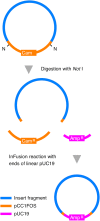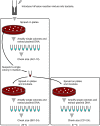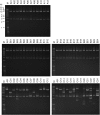Reduction in the structural instability of cloned eukaryotic tandem-repeat DNA by low-temperature culturing of host bacteria
- PMID: 25578068
- PMCID: PMC7045003
- DOI: 10.1017/S0016672314000172
Reduction in the structural instability of cloned eukaryotic tandem-repeat DNA by low-temperature culturing of host bacteria
Abstract
Summary For accurate analyses of eukaryotic tandem-repeat DNA, it is often required to clone a genomic DNA fragment into a bacterial plasmid. It is, however, a serious problem that tandem-repeat DNA is frequently subjected to structural changes during maintenance or amplification in the host bacteria. Here, we show an example of a clear difference in the instability of tandem-repeat DNA between different culturing temperatures. A fragment of monkey centromeric DNA carried by pUC19 was considerably degraded by culturing bacteria at 37 °C, but the damage was reduced at 25 °C. Thus, culturing temperature is a significant factor for avoiding degradation, in addition to the genotype of the host bacteria.
Figures



Similar articles
-
Mechanisms of tandem repeat instability in bacteria.Mutat Res. 2006 Jun 25;598(1-2):144-63. doi: 10.1016/j.mrfmmm.2006.01.020. Epub 2006 Mar 7. Mutat Res. 2006. PMID: 16519906 Review.
-
Instability of bacterial artificial chromosome (BAC) clones containing tandemly repeated DNA sequences.Genome. 2001 Jun;44(3):463-9. Genome. 2001. PMID: 11444706
-
Generating tandem repeats by cloning with double initiator fragments.Biotechniques. 2001 Aug;31(2):340-5, 347. doi: 10.2144/01312st06. Biotechniques. 2001. PMID: 11515371
-
Radiation-induced genomic instability in tandem repeat sequences is not predictive of unique sequence instability.Radiat Res. 2007 May;167(5):526-34. doi: 10.1667/RR0799.1. Radiat Res. 2007. PMID: 17474793
-
Indirect mechanisms of genomic instability and the biological significance of mutations at tandem repeat loci.Mutat Res. 2006 Jun 25;598(1-2):61-72. doi: 10.1016/j.mrfmmm.2006.01.015. Epub 2006 Feb 28. Mutat Res. 2006. PMID: 16504216 Review.
Cited by
-
Population Scale Analysis of Centromeric Satellite DNA Reveals Highly Dynamic Evolutionary Patterns and Genomic Organization in Long-Tailed and Rhesus Macaques.Cells. 2022 Jun 17;11(12):1953. doi: 10.3390/cells11121953. Cells. 2022. PMID: 35741082 Free PMC article.
-
A Recombinant System and Reporter Viruses for Papiine Alphaherpesvirus 2.Viruses. 2022 Jan 5;14(1):91. doi: 10.3390/v14010091. Viruses. 2022. PMID: 35062295 Free PMC article.
-
CENP-B box, a nucleotide motif involved in centromere formation, occurs in a New World monkey.Biol Lett. 2016 Mar;12(3):20150817. doi: 10.1098/rsbl.2015.0817. Biol Lett. 2016. PMID: 27029836 Free PMC article.
-
CloneFast: A simple plasmid design and construction guide for labs venturing into synthetic biology.STAR Protoc. 2025 Aug 6;6(3):104025. doi: 10.1016/j.xpro.2025.104025. Online ahead of print. STAR Protoc. 2025. PMID: 40773353 Free PMC article. Review.
-
Higher-order repeat structure in alpha satellite DNA occurs in New World monkeys and is not confined to hominoids.Sci Rep. 2015 May 14;5:10315. doi: 10.1038/srep10315. Sci Rep. 2015. PMID: 25974220 Free PMC article.
References
-
- Brutlag D., Fry K., Nelson T. & Hung P. (1977). Synthesis of hybrid bacterial plasmids containing highly repeated satellite DNA. Cell 10, 509–519. - PubMed
-
- Doherty J. P., Lindeman R., Trent R. J., Graham M. W. & Woodcock D. M. (1993). Escherichia coli host strains SURE and SRB fail to preserve a palindrome cloned in lambda phage: improved alternate host strains. Gene 124, 29–35. - PubMed
-
- Maio J. J. (1971). DNA strand reassociation and polyribonucleotide binding in the African green monkey, Cercopithecus aethiops. Journal of Molecular Biology 56, 579–595. - PubMed
Publication types
MeSH terms
LinkOut - more resources
Full Text Sources
Other Literature Sources
